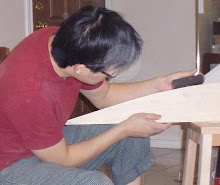


These are the lessons from a cabinet salesman who takes on woodworking from a pragmatic point of view.




I finally like my router. I purchased a Craftsman router about six years ago, when I first decided to do get into woodworking. It’s a one horsepower basic model I purchased for $99. Norm Abram used it all the time in New Yankee Workshop and I felt I should have one. I plugged it in, turned it on, and the bit grabbed the wood, shot shavings all over the place as the motor screams to a deafening sound, dust filled the living room and then the smoke alarm went off. I wrapped up, put it away and rarely used it unless absolutely necessary.
That episode along with my table saw purchase scared me into hand tools. I am glad because the use of hand tools slowed me down and allowed me to be a better woodworker, being more in tuned with the wood and the cutting process. But I'm getting older and hand cutting with expensive handsaws is getting old. I want more efficiency. Do I want more power?
The power comes from an electric motor. Our shopping culture is obsessed with the “more power” concept. The manufacturers would gladly take a cheaper weaker ¾ horsepower motor, tweak it to provide maxium power though not efficiently and sell it a 1 horsepower router that screams to the top of it’s lung each time it is turned on.
After hand cutting wood for all these years, I found that my 1/10 horsepower right arm can cut pretty well with a sharp blade. So I purchased a variable speed router controller hoping this would tame the router. At $39 this device pulse current to the motor so that it runs slower. Since it sends pulses of full current like a capacitor and not weakened the current like a resistor, the torque of the motor is not sacrificed. This little addition tamed my once loud screaming uncontrollable wood burner to a civilized piece of wood sculpting masseur. Of course I have to make more passes with the router since it takes off less pieces of wood at a time, but I don’t have the loud sounds, I don’t have the pieces of wood shooting across the room, and not cloud of dust that sets off the fire alarm. I’m beginning to like variable speed power tools. This will change the way I work.

As part of my plan to get more woodworking done in 2009, I made a gate for the kitchen, keeping the place off limits to the dogs. Well behaved as they pretend to be, they cannot resist the urge to counter surf when we’re not around. The solution was to train the dog not to do this, not leave food on the counter or build a gate. The latter was the easiest choice.

First thing was to get the door to the stretcher to increase 5” in width. No, just kidding, I couldn’t afford that contraption. I just cut off the routed edges and then joined 3x6” oak to it with #20 biscuits. The joints on cabinet doors are pretty weak, so I drilled and glued in a bunch of 3/8” dowels from the new extra wide styles to the rails. That should make it strong enough for some abuse. Oak joined next to cherry? Yes. I don’t care,, the dogs are going to scratch the heck out of it anyways and I stained the oak the match the existing oak trim to make it a little classier. I did hand carved the end grain of the oak to match the profile of the cherry d
oor. It’s the details I’m after in this project.
The door hangs on cabinet style European cup hinges from one of my past projects. I only have two, clearly not enough to handle the weight of this newly expanded door, so I solve it by putting a swivel cast I happen to have in my “pile”.

That’s the project. The whole thing can be removed when I’m ready to sell the house with out any damage to the existing casing.
